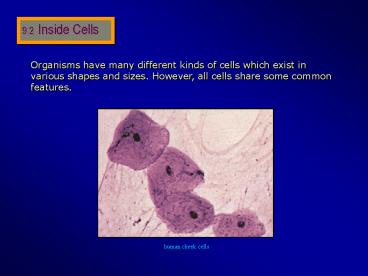From Cells to Organisms - PowerPoint PPT Presentation
1 / 8
Title:
From Cells to Organisms
Description:
jelly-like substance that fills the cell. contains water and many other substances ... contain chlorophyll. Chromosomes, Genes and Heredity. Definition: ... – PowerPoint PPT presentation
Number of Views:60
Avg rating:3.0/5.0
Title: From Cells to Organisms
1
9.2 Inside Cells
Organisms have many different kinds of cells
which exist in various shapes and sizes. However,
all cells share some common features.
human cheek cells
2
Animal Cells
cell membrane
- thin layer around the cell, allowing shape of
cell to change - partially permeable
cytoplasm
- jelly-like substance that fills the cell
- contains water and many other substances
- involves chemical reactions
nucleus
vacuoles
- controls cell activities
- contains chromosomes
- small spaces containing air, liquid or food
particles - numerous in animals
3
Plants Cells
chloroplasts
cell wall
- small disc-like structures found in the cells of
green plants - contain chlorophyll
- thick layer around the cell
- made up of tough substance (cellulose)
- supports the cell and gives it a regular shape
cell membrane
- thin layer around the cell, allowing shape of
cell to change - partially permeable
vacuole
cytoplasm
- single large space containing liquid (cell sap)
- cell sap contains water and dissolved substances
(eg. sugar and salt) - cell sap keeps the cell firm by taking in water
nucleus
- jelly-like substance that fills the cell
- contains water and many other substances
- involves chemical reactions
- controls cell activities
- contains chromosomes
4
Chromosomes, Genes and Heredity
What are Chromosomes???
- Definition
- They are the thread-like objects found in the
nucleus in each cell. They carry information
which controls - how the cell works
- what the organism will look like
5
Chromosomes, Genes and Heredity
Different organisms contain different numbers of
chromosomes in their cells. In a human cell
there are 46 (or 23 pairs) of chromosomes.
nucleus
genes on a chromosome
chromosomes
each chromosome is made up of many genes each
gene contains instructions for a different
feature of an organism
6
Comparing between Animal and Plant Cells
7
Dead Cells
A living plant cell has a cell wall, a nucleus
and cytoplasm. When a cell dies, the nucleus and
cytoplasm become part of the cell wall. The
remainder of the cell becomes a large space
containing only air. Example cork
8
Cells - Two-dimensional or Three-dimensional
Are cells two-dimensional or three-dimensional?
Cells are actually three-dimensional,
not flat.

